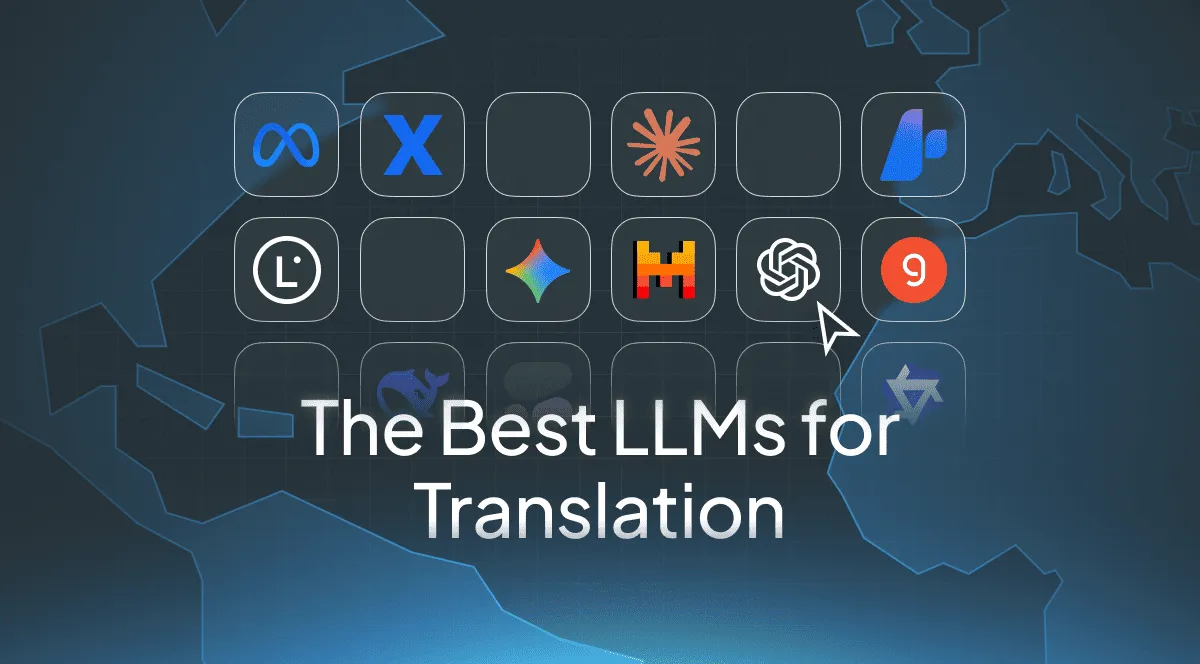There’s a big variety of Large Language Models, but which one to consider for your tasks? This guide provides a comparison of the top large language models for translation, information about how top LLMs differ in speed, cost, and the list of supported languages.
You will also explore how to build an effective localization strategy and get insights about a hybrid approach of using different LLMs for different tasks, depending on your needs.
So, stay with us to discover how Crowdin offers flexibility in selecting various LLMs within a single platform.
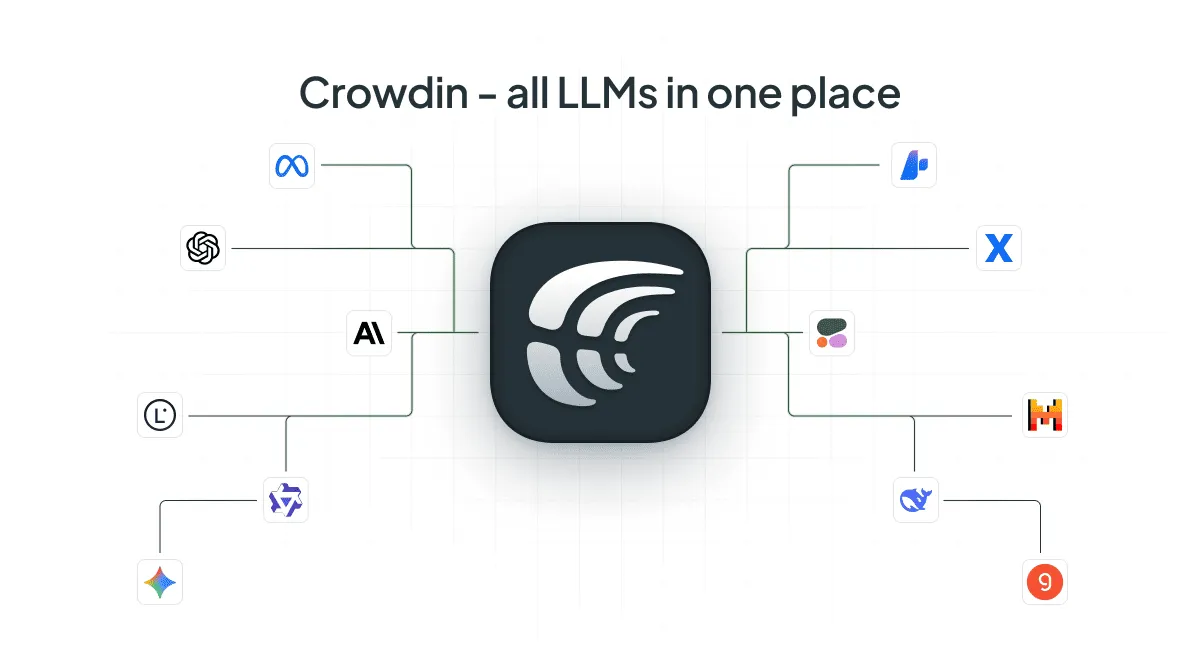
What are Large Language Models?
LLMs, or Large Language Models, are programs that understand and create text. They’re trained on a huge amount of information from the internet and books, so LLMs have learned how human language works. This allows them to do things like write stories, answer questions, and, of course, translate.
Translators and managers use LLMs for:
- Speed – LLMs generate fast first drafts, saving time for the translator to edit.
- Consistency – They help maintain the same words and style for large projects.
- Quality Control – Translators check and fix the AI’s work, focusing on a natural and accurate final product.
- Assistance – LLMs suggest different phrases and help with difficult research.
Let’s dive into the latest Large Language Models available on the market.
GPT-5 family
The GPT-5 family from OpenAI is designed as a tiered solution. It has a larger context window of up to 400,000 tokens, which improves its ability to maintain consistency across long documents. Furthermore, GPT-5 has been trained to have a lower hallucination rate. Some benchmarks show it is up to 45% less likely to produce a factual error compared to GPT-4o.
GPT-5 Model Comparison for Translation Needs
| GPT-5 | GPT-5-mini | GPT-5-nano | |
|---|---|---|---|
| Ideal for | Deep reasoning, complex tasks, and high-stakes content like legal or medical documents. It is also the best choice for agentic workflows and long-form content. | General-purpose translation and high-volume, moderately complex tasks like website content and product documentation. Offers a strong balance of performance, speed, and cost. | High-volume, low-risk content, such as social media feeds and real-time chat. Perfect for initial drafts and simple tasks like text classification. |
| Cost | Most expensive. Approximately $1.25 per million input tokens and $10 per million output tokens. | Cost-effective. Approximately $0.25 per million input tokens and $2.00 per million output tokens. | Cheapest. Approximately $0.05 per million input tokens and $0.40 per million output tokens. |
| Speed | Designed for deep reasoning, which may involve a more thorough, slower process. | Offers a performance increase over older models while providing a balance of speed and quality. | Fastest model, optimized for ultra-low latency. |
| Supported Languages | Over 95 languages | Over 95 languages | Over 95 languages |
| Context Window | Up to 400,000 tokens, enabling it to process and maintain context across entire books or large technical manuals. | The context window is not explicitly stated in the provided text for this model, but it is implied to be smaller than the flagship model. | The context window is not explicitly stated, but it’s the smallest in the family, optimized for speed over long-term context. |
| Key Strength | Superior reasoning and lower hallucination rate. Excels at complex, multi-step tasks with greater reliability. | Offers a balance of performance, speed, and cost, making it the ideal choice for the majority of translation needs. | Optimized for ultra-low latency and minimal cost, making it the most efficient choice for simple tasks. |
| Hallucination Rate | Lowest in the GPT-5 family, crucial for high-stakes tasks. | Higher than the flagship model, but still suitable for general-purpose use. | Highest of the three models due to its smaller size, reflecting the trade-off for speed and cost. |
GPT-5: The Flagship Model
This is the most capable model in the GPT-5 family, designed for deep reasoning and complex tasks.
When to Use GPT-5 Model for Translation:
- High-Stakes and Nuanced Content: Use GPT-5 for translating legal documents, medical reports, or high-value marketing campaigns where a single misinterpretation can have serious consequences. Its superior reasoning and lower hallucination rate are crucial here.
- Complex Agentic Workflows: If your localization process involves multiple steps – such as analyzing a technical diagram, extracting the text, translating it, and then placing it back into a new image – GPT-5 is the best choice. It can handle these multi-step tasks with greater reliability than its smaller counterparts.
- Long-Form Content: With a context window of up to 400,000 tokens, it can process and maintain context across entire books or large technical manuals, ensuring terminology and style consistency.
Cost: $1.25 per million input tokens and $10 per million output tokens. GPT-5 is the most expensive.
GPT-5-mini: The Workhorse Model
This model offers an excellent balance of performance, speed, and cost. It’s ideal for the majority of a company’s localization needs.
When to Use GPT-5-mini Model for Translation:
- General-Purpose Translation: GPT-5-mini is a good choice for the bulk of your website content, UI strings, and product documentation. Its quality is great, and it provides a noticeable performance increase over older models without the premium cost of the flagship GPT-5.
- High-Volume, Moderately Complex Tasks: For projects that require both speed and good quality, such as translating a large number of knowledge base articles or customer support tickets.
Cost: $0.25 per million input tokens and $2.00 per million output tokens. This makes it cost-effective for enterprise-scale operations.
GPT-5-nano: The Speed and Cost Champion
This is the smallest and fastest model in the GPT-5 family, optimized for ultra-low latency and minimal cost.
When to Use the GPT-5-nano Model for Translation:
- High-Volume, Low-Risk Content: Use nano for translating content where speed and cost are the primary concerns. Examples include social media feeds, user-generated content, or real-time chat.
- Initial Drafting: It can be used for a very quick, machine-generated first pass on a large document, which a human translator can then refine.
- Simple Tasks: For simple tasks like text classification (e.g., categorizing customer reviews by language) or short-form summarization, nano is the most efficient choice.
Cost: $0.05 per million input tokens and $0.40 per million output tokens.
Recommended Strategy for Translation

An effective strategy for using GPT-5 for translation isn’t about choosing a single model, but about using a combination of models.
- Critical Content: Use GPT-5 for your most important, high-value translation work, such as legal or creative content. It provides maximum quality and a lower hallucination rate, which is crucial for a localization manager’s key responsibility: delivering accurate and culturally appropriate content.
- High-Volume Content: Use GPT-5-mini for the bulk of your general translation needs, where you need a balance of quality, speed, and cost.
- Low-Risk Content: Use GPT-5-nano for basic, high-volume translations where minimal cost is the main concern.
This approach helps localization teams optimize their workflow and budget.
Gemini 2.5 family
The Gemini 2.5 family from Google represents a leap forward in AI, especially for translation. Gemini 2.5 was built from the ground up to be natively multimodal. It can process and reason over text, images, video, and audio simultaneously. Because Gemini 2.5 models can “think” and reason, they produce more accurate translations.
Choosing the Right Gemini 2.5 Model for Your Translation Tasks
| Gemini 2.5 Pro | Gemini 2.5 Flash | Gemini 2.5 Flash-Lite | |
|---|---|---|---|
| Ideal For | High-stakes and nuanced translations, complex reasoning, long-form content, multimodal tasks involving video and images. | High-volume, low-latency tasks, general-purpose translation (websites, UI), and moderately complex projects. | High-throughput, cost-sensitive, and low-latency tasks, such as real-time chat, basic translations, and initial drafts. |
| Cost (per 1M tokens) | Most expensive. Input: ~$1.25 Output: ~$10.00 | Cost-effective. Input: ~$0.30 Output: ~$2.50 | Cheapest. Input: ~$0.10 Output: ~$0.40 |
| Speed | Optimized for deep reasoning, resulting in a slower response time. | Provides a balance of speed and quality, suitable for high-volume, low-latency applications. | The fastest model, optimized for ultra-low latency and real-time use cases. |
| Supported Languages | Over 40 languages, improved accuracy for non-English languages. | Over 40 languages | Over 40 languages |
| Context Window | Up to 1 million tokens, allowing it to process and maintain context across entire documents or video/audio files. | Up to 1 million tokens, capable of handling large inputs for cost-efficient processing. | Up to 1 million tokens, maintaining the long-context capability for high-throughput, low-cost tasks. |
| Key Strength | Enhanced reasoning, high accuracy, and best-in-class performance on complex benchmarks like mathematics and coding. | The optimal model for price-performance balance, offering strong capabilities at a reasonable cost. | The most cost-efficient model in the family, with a focus on speed and throughput. |
| Hallucination Rate | Lowest in the Gemini 2.5 family. The model is designed for high accuracy and provides the most reliable factual responses. | The hallucination rate is higher than the Pro model, but it is still considered to be low and suitable for most general-purpose tasks. | Highest in the Gemini 2.5 family due to its optimization for speed and cost over deep reasoning and factual accuracy. |
Gemini 2.5 Pro: The Most Capable
Gemini 2.5 Pro is Google’s flagship model, representing the peak of their AI technology.
When to Use Gemini 2.5 Pro Model for Translation:
- Complex Reasoning and Nuance: It excels at understanding and generating complex language. This makes it the best choice for translating legal texts, medical manuals, and creative content.
- Massive Context: With a context window of up to 1 million tokens, it can process and understand entire documents, videos, or codebases. This is a solution for maintaining consistent terminology and style across a long document.
- Multimodal Tasks: Gemini 2.5 Pro is natively multimodal. It can take in text, images, video, and audio and provide a text output. This makes it invaluable for localizing videos, screenshots, or any content with mixed media.
Cost: $1.25 per million input tokens and $10 per million output tokens for prompts up to 200k tokens, with prices increasing for larger inputs.
Gemini 2.5 Flash: The Speed and Cost-Effective Choice
Gemini 2.5 Flash is a lightweight, efficient model built for speed and high-volume tasks.
When to Use Gemini 2.5 Flash for Translation:
- High-Volume, Low-Latency Tasks: It’s the ideal model for real-time translation in applications like chatbots, customer support, or live video conferencing, where speed is more important than absolute perfection.
- Cost-Efficiency: Its lower price makes it the best choice for translating large volumes of non-critical content, such as user-generated reviews, internal emails, or social media feeds.
- “Good Enough” Quality: It is capable of most general translation needs. It’s an “workhorse” model for the majority of a company’s localization needs.
Cost: $0.30 per million input tokens and $2.50 per million output tokens.
Gemini 2.5 Flash-Lite: The Cheapest Option
Flash-Lite is a variant optimized for the absolute lowest cost and highest throughput.
When to Use Gemini 2.5 Flash-Lite for Translation:
- Bulk Translation: Use this model for simple, high-volume tasks where cost is the main concern, like internal documents or basic texts.
- Limited Budgets: It provides a great entry point for smaller projects or for teams on a very tight budget.
Cost: $0.075 per million input tokens and $0.30 per million output tokens.
Recommended Strategy for Translation Needs
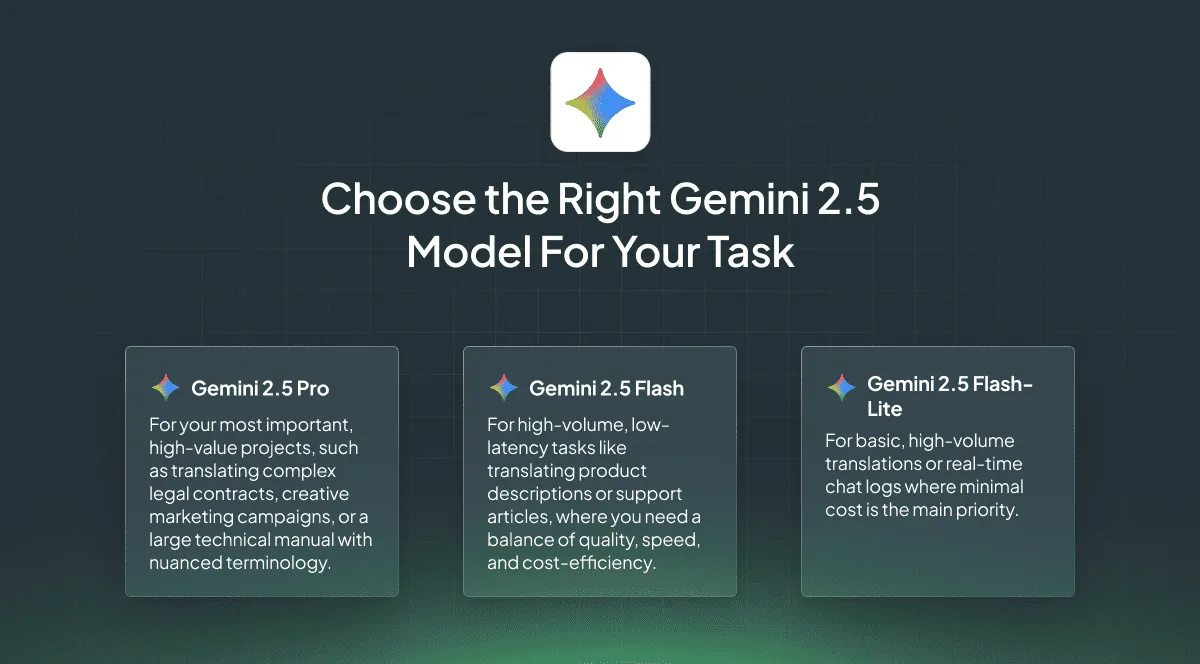
The best approach to localization isn’t using a single Gemini model, but a strategic mix of models.
- Critical Content: Use Gemini 2.5 Pro for your most important, high-value translations.
- High-Volume Content: Use Gemini 2.5 Flash for the bulk of your general translation needs, where you need a balance of quality, speed, and cost.
- Low-Risk Content: Use Gemini 2.5 Flash-Lite for basic, high-volume translations where minimal cost is the main concern.
A tiered approach helps you match the quality and cost to each task, which optimizes workflow and budget.
Lara Translate
Unlike general-purpose LLMs, Lara is an AI model trained by Translated on a massive dataset of 25 million real and professional human translations. This focus allows it to excel in three key areas:
- Human-Quality Output: It provides highly accurate and natural-sounding translations with a lower rate of errors.
- Contextual Understanding: It maintains consistent terminology and style by analyzing entire documents, not just isolated sentences.
- Document Translation: Lara keeps context, tone, and brand terms consistent across DOCX, PPTX, and other common formats. All with secure handling.
- Adaptability: It offers specific features like translation styles (Faithful, Fluid, Creative) and glossary management, which are important for professional workflows.
Lara Translate Features and Performance
| Lara Translate | |
|---|---|
| Ideal For | Individuals, businesses, and enterprises needing high-quality, secure, and context-aware translations. It’s particularly well-suited for legal, technical, and marketing content. |
| Speed | Exceptionally fast (real-time translations), with 99% of translations completed in 1.2 seconds. It is reported to be faster than general-purpose LLMs. |
| Key Strengths | Near-professional quality, deep contextual understanding, ability to explain translation choices, multiple translation styles (Fluid, Faithful, Creative), and privacy features (incognito mode, encrypted translations). |
| Supported Languages | Over 200 languages |
| Supported File Formats (for document translation) | Over 50 different file formats supported for all possible needs (docx, docm, xlsx, xlsm, otp, odp, pptx, pptm, pdf, csv, xml, json, mif, idml, xliff, srt, txt, and many more). |
| Cost | It offers a Free plan. Paid plans include a Pro plan at €9/month and a Team plan at €29 per user/month, with custom enterprise solutions also available. |
| Key Features | Context-aware translations, instant document translation (preserving formatting), real-time conversation interpretation, language detection, ambiguity flagging, and an API for developers. |
When to Choose Lara Over Traditional LLMs?

While general LLMs like GPT and Gemini can translate, Lara Translate is a specialized tool optimized for the task.
Choose Lara Translate when you need:
- Higher Accuracy: Trained on billions of translated texts, it excels at handling specific terminology.
- Time-to-Market and Scale: This model is designed for high-volume and real-time translation. It can process large documents and batches much faster than a standard LLM.
- Workflow Integration: It supports 50+ file formats and integrates with localization platforms, offering a complete solution for businesses.
- Enhanced Security: It provides a secure, privacy-first approach with features like encrypted “incognito mode” translations.
Lara Translate is perfect for translating big projects and specialized content. It’s the best tool when you need speed and accuracy while keeping your data private.
Claude 4 family
The Claude 4 models from Anthropic are a major step forward for AI localization. The Opus model is the most expensive, but its high cost is justified. It’s built for critical and complex tasks that require deep reasoning, accuracy, and reliability.
The models are also designed with a “Constitutional AI” framework to ensure safe and ethical outputs, making them a great choice for sensitive content. Claude 4 can process entire documents or codebases while maintaining accuracy.
Claude 4 Model Comparison for Translation
| Claude 4.1 Opus | Claude 4 Sonnet | |
|---|---|---|
| Ideal For | High-stakes content (legal, creative), advanced coding, and complex, long-running agentic workflows. | General-purpose translation, high-volume content, and day-to-day tasks where a balance of speed and cost is key. |
| Cost (per 1M tokens) | Most expensive. Input: $15 Output: $75 | Most cost-effective. Input: $3 Output: $15 |
| Speed | Slower, output speed of 44.3 tokens per second. | Faster, output speed of 61.8 tokens per second |
| Supported Languages | Strong multilingual support across a wide range of languages, with a focus on deep reasoning and nuance in non-English texts. | Strong multilingual support, offering a balance of speed and quality for a wide range of language pairs. |
| Context Window | A large context window of 200,000 tokens (with a beta for 1M tokens), ideal for digesting entire documents or codebases. | A large context window of 200,000 tokens (with a beta for 1M tokens), offering a deep memory for long documents at a lower cost. |
| Key Strength | Unrivaled deep reasoning and long-term memory make it the best choice for high-stakes, analytical work. | The optimal model for price and performance, delivering near-Opus quality at a fraction of the cost. |
| Hallucination Rate | Lowest in the Claude 4 family. Designed for superior factual accuracy and reliability, especially in complex, multi-step reasoning. | Low and reliable for most tasks. It may have a slightly higher rate than Opus, but still provides high-quality output. |
Claude 4.1 Opus
Opus is Anthropic’s flagship, most powerful, and most expensive model. It’s designed to handle complex tasks and deep, analytical thinking.
When to Choose the Claude 4.1 Opus Model:
- High-Stakes Content: Use Opus for legal documents, medical translations, or creative marketing campaigns where a single mistake could be very costly. It excels at understanding nuanced context and delivering highly accurate, fluent translations that require minimal post-editing.
- Complex Workflows: Opus is designed for multi-step, agentic tasks. It can handle a translation project that involves reading multiple source documents, synthesizing information, and then generating a single, cohesive output.
- Long-form Documents: While Sonnet and Haiku also have large context windows, Opus’s superior reasoning and long-term memory make it the ideal choice for translating entire books or extensive manuals.
Cost: $15 per million input tokens and $75 per million output tokens. This is five times more expensive than Sonnet.
Claude 4 Sonnet
Sonnet is the middle-ground model, offering an excellent balance of performance, speed, and cost. It’s the most widely used model in the Claude family, handling the majority of general-purpose tasks.
When to Choose the Claude 4 Sonnet Model:
- General-Purpose Translation: Sonnet is a great choice for the bulk of your localization work, such as translating website content, user interface text, or knowledge base articles. It provides a quality boost over older models without the high cost of Opus.
- Cost-Efficiency: For companies with a large volume of content to translate, Sonnet’s lower price makes it the most practical option. Many companies use a “hybrid” approach, using Sonnet for 80% of their content and reserving Opus for the most critical 20%.
- Integration and Speed: Sonnet is optimized for high-volume, lower-latency tasks. It’s a fantastic fit for real-time applications like chatbots or for translating large batches of customer support tickets.
Cost: $3 per million input tokens and $15 per million output tokens.
Recommended Strategy for Translators
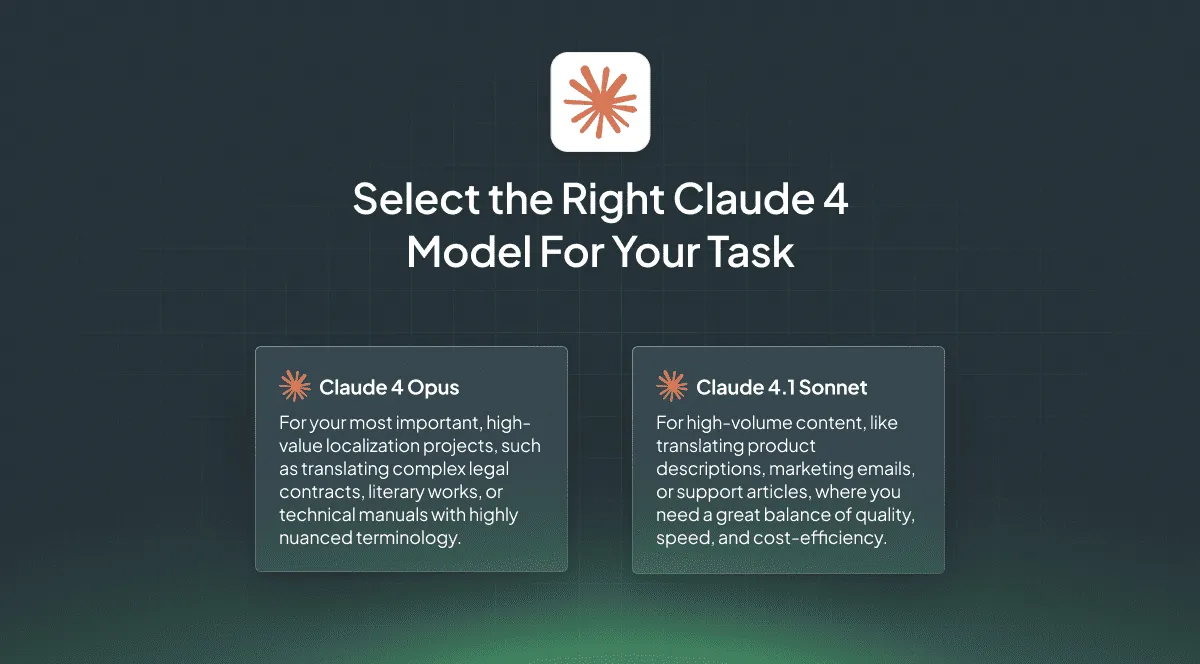
The choice of the best Claude 4 model for localization isn’t a one-size-fits-all solution; it’s about a strategic workflow.
Because the Opus model comes with a premium in cost due to its superior reasoning and reliability, it is best reserved for your most critical tasks. This includes high-stakes legal, medical, or creative content where a single error could be costly.
For the vast majority of your day-to-day translation work, including website content and general documents, the more affordable and faster Sonnet model provides a balance of quality, speed, and cost-efficiency.
By adopting this tiered approach, you can maximize the value of the Claude 4 family while keeping your budget in check.
Meta’s Leading Models: LLaMA 4 family and NLLB-200
At Meta, the landscape is defined by two key players: the versatile LLaMA 4 family and the specialized NLLB-200 model.
Let’s break down their unique strengths and help you decide which is the right fit for your business.
A Quick Comparison: LLaMA 4 Maverick, LLaMA 4 Scout, and NLLB-200
| LLaMA 4 Maverick | LLaMA 4 Scout | NLLB-200 | |
|---|---|---|---|
| Ideal For | Creative and nuanced content, and handling multimodal inputs like images and video. | Deep analysis of extremely long documents, where consistency is critical. | High-volume, cost-effective translation across a massive number of languages. |
| Output Speed | High. ~142 tokens/sec. | High. ~114 tokens/sec. | Varies widely, but typically low for general use. |
| Supported Languages | Excels in a dozen core languages but has a foundational understanding of 200+. | Same multilingual capabilities as Maverick, with a focus on deep, long-form analysis. | A true specialist designed for high-quality translation across 200 distinct languages. |
| Cost | ~$0.19-$0.49 per 1M tokens. | ~$0.10 input/$0.50 output per 1M tokens. | The model is free to use; cost is for hardware only. |
| Core Strength | Balance of intelligence, speed, and cost for general-purpose use. | The ability to “remember” and reason over entire books or codebases. | The single model that provides high-quality translation for 200 languages. |
| Context Window | 1 million tokens | 10 million tokens (Industry-leading) | Up to 512 tokens |
| Hallucination Rate | Low. ~4.6% in a controlled test. | Low. ~0.58% in a controlled test. | Lower for high-resource languages, but can be higher for low-resource languages. |
LLaMA 4 Maverick: Your Go-To for Creative and Nuanced Content
LLaMA 4 Maverick is a reliable and efficient model. It’s built for complexity and nuance, making it the perfect choice for projects that require a sophisticated touch.
- Creative Excellence: If you need to translate marketing copy, adapt a brand’s tone of voice, or translate complex prose, Maverick’s superior reasoning and creative capabilities are a huge advantage.
- A Multimodal Game-Changer This model can understand both text and images. This is a game-changer for localizing visual content like product diagrams, instructional screenshots, or video subtitles – a task that’s historically been quite challenging.
- Practicality: While it’s a premium model, its performance-to-cost ratio is good. It offers the kind of power you’d expect from a top-tier generalist model.
LLaMA 4 Scout: The Ultimate Specialist for Long-Form Content
Where Maverick is the all-around athlete, LLaMA 4 Scout is the marathon runner. It’s built for one specific, incredibly demanding task: handling exceptionally long documents.
- Unparalleled “Memory”: Its defining feature is a massive 10-million-token context window. This means it can maintain consistency across an entire book, a full legal contract, or a sprawling technical manual–a feat that’s simply not possible with other models.
- The Power of Consistency: For industries like publishing, law, or technical documentation, ensuring consistent terminology is critical. Scout’s ability to maintain context over thousands of pages makes it the ideal tool for these high-stakes projects.
- Remarkably Efficient: Despite its incredible context window, Scout is designed to be highly efficient, making it a surprisingly cost-effective solution for its specialized purpose.
NLLB-200: The Champion of Linguistic Diversity
NLLB-200 (“No Language Left Behind”) is an AI model specifically designed for machine translation. Its primary goal is to provide high-quality translations for a massive number of languages, particularly those that are often underrepresented. The NLLB-200 excels in language pair translation, providing high-quality results for 200 different languages.
- Wide language coverage: NLLB-200 is unparalleled in its breadth, with a single model capable of translating across 200 different languages. For software localization teams that need to support a vast number of languages, including low-resource ones like Høgnorsk or Icelandic, NLLB-200 is the best, and often only, choice.
- Cost-Effective by Design: Since it’s an open-source model, you’re not paying a per-call fee. You’re only paying for the computational resources to run it, which can lead to savings at scale.
- A Reliable Workhorse: This model is a specialist, trained specifically in translation. This focus means it has a very low hallucination rate, providing reliable, high-quality output for a wide range of content, from customer support tickets to internal documents.
Making the Right Choice for Translation Strategy
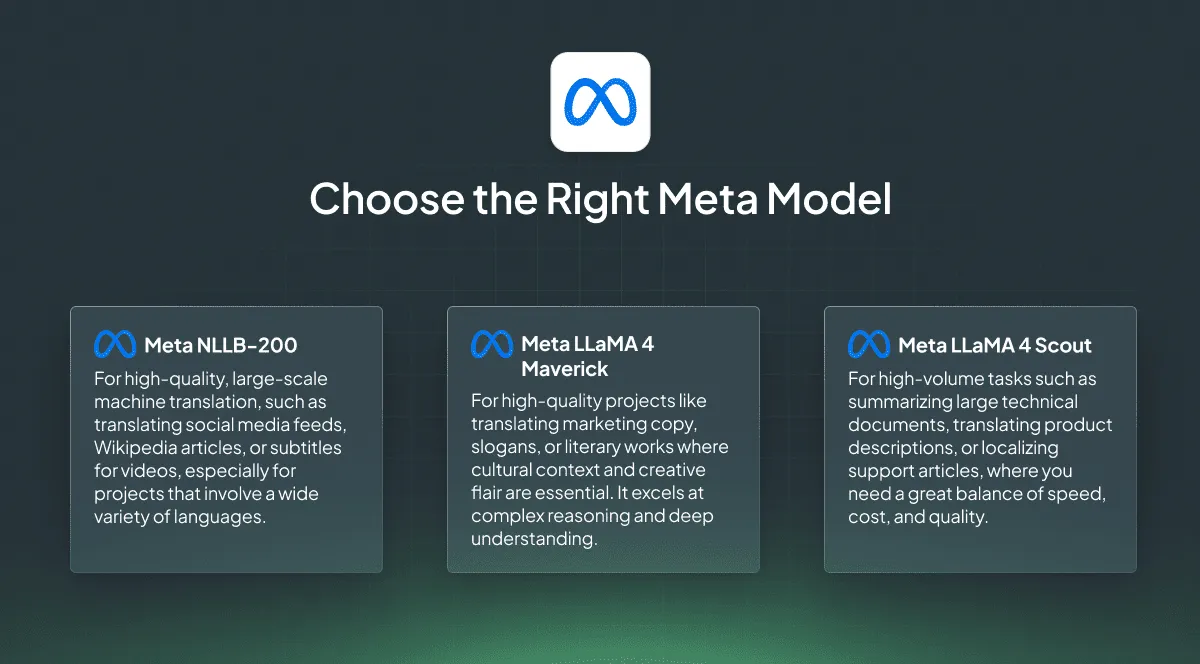
The best model from Meta depends on your core objectives:
- If your focus is on premium quality, creative content, and multimodal tasks, LLaMA 4 Maverick is your partner. It’s the best general-purpose tool on the market.
- If your project demands absolute consistency across massive documents, LLaMA 4 Scout is the specialized solution that will give you an unparalleled advantage.
- If your priority is cost-effective, high-volume translation across a diverse set of languages, NLLB-200 is the unmatched champion.
Alibaba Qwen
As a model developed by a Chinese company, Qwen consistently shows superior results in Chinese-English translation, with a deeper understanding of cultural nuances and idioms. It also excels in other major Asian languages such as Japanese, Korean, and Vietnamese, where it often outperforms competitors.
Alibaba Qwen Model Comparison for Translation
| Qwen-MT | Qwen-Plus | Qwen-Turbo & Qwen-Flash | |
|---|---|---|---|
| Ideal For | High-volume, high-stakes content like legal documents and professional documentation. | Moderately complex, everyday translation tasks, such as website content and knowledge bases, where a balance of performance and cost is needed. | High-volume, low-risk content, such as real-time chat, user-generated content, or a first draft for human post-editing. |
| Supported Languages | A specialist model with a strong focus on Asian languages that supports 92 official languages. | A versatile model with strong multilingual capabilities, supporting over 100 languages and dialects with marked improvements in translation. | Optimized for efficiency across a wide range of languages. |
| Cost | Competitive. Input: ~$0.16 to $2.46 Output: ~$0.49 to $7.37 | Balanced. Input: ~$0.40 Output: ~$1.20 | Cheapest. Input: ~$0.10 to ~$0.16 Output: ~$0.28 to $0.49 |
| Speed/Latency | Extremely fast and efficient due to its specialized architecture, achieving rapid translation processing. It is designed for high-concurrency environments. | Balances performance with speed, offering a responsive experience for most enterprise applications. | Fastest models, optimized for low latency and high throughput for real-time applications. |
| Context Window | The Qwen-MT model has a context window of 4,096 tokens. | The stable version has a context window of 131,072 tokens. | The context window is optimized for efficiency. |
| Hallucination Rate | Low. This model is specifically trained on a massive dataset of professional translations, resulting in a low rate of errors and high fluency. | Reliable for most tasks. Its advanced training and human preference alignment help reduce factual errors. | Optimized for speed and cost, with a higher propensity for errors or hallucinations on complex, nuanced tasks. |
| Key Strength | A highly accurate and fluent specialist model for machine translation, with superior performance in Chinese and other major Asian languages. | An excellent all-around model that provides a strong balance of performance, speed, and cost for a wide range of tasks. | The most cost-effective and fastest models, ideal for real-time and high-volume needs. |
Qwen-MT: Machine Translation
Qwen-MT, built on the Qwen3 foundation, is a specialist machine translation model from Alibaba. It is specifically trained on trillions of multilingual and translation-specific tokens. This model uses reinforcement learning to improve its accuracy, fluency, and idiomatic expression.
Qwen-MT is The Best for:
- High-volume, high-stakes content, such as legal and professional documentation, where quality is paramount.
- Translation for major Asian languages like Chinese, Japanese, and Vietnamese requires a deeper understanding of cultural nuances.
- Maintaining consistent translation of brand names and technical terms through features like terminology control and domain prompts.
Cost: Input: ~$0.16 to $2.46 per million tokens. Output: ~$0.49 to $7.37 per million tokens.
Qwen-Plus: Balanced Performance
Qwen-Plus is a versatile, middle-tier model in the Alibaba Qwen family. It offers a strong balance of performance, speed, and cost for localization. It supports over 100 languages and dialects with a large context window, making it suitable for a wide range of tasks.
Qwen-Plus is The Best for:
- General-purpose translation, such as website content, UI strings, and knowledge base articles.
- Moderately complex projects that require a balance of performance and cost.
- Multilingual tasks, with a particular focus on Chinese and English, but strong support for other languages.
Cost: Qwen-Plus is cost-effective, with pricing around $0.40 per million input tokens and $1.20 per million output tokens.
Qwen-Turbo & Qwen-Flash (Speed & Cost)
Qwen-Turbo and Qwen-Flash are the fastest and most cost-effective models in the Qwen family, optimized for ultra-low latency and high-volume throughput. They are designed for straightforward translation tasks where speed and minimal cost are the main priorities.
Qwen-Turbo & Qwen-Flash are The Best for:
- High-volume, low-risk content, such as real-time chat, social media feeds, and user-generated content.
- Initial drafts for human post-editing.
- Real-time applications where speed is more important than absolute perfection.
Cost: Qwen-Turbo pricing is approximately $0.05 per million input tokens and $0.20 per million output tokens. Qwen-Flash has a tiered pricing structure, with a minimum cost of $0.05 per million input tokens and $0.40 per million output tokens.
Hybrid Approach for Alibaba Qwen Models
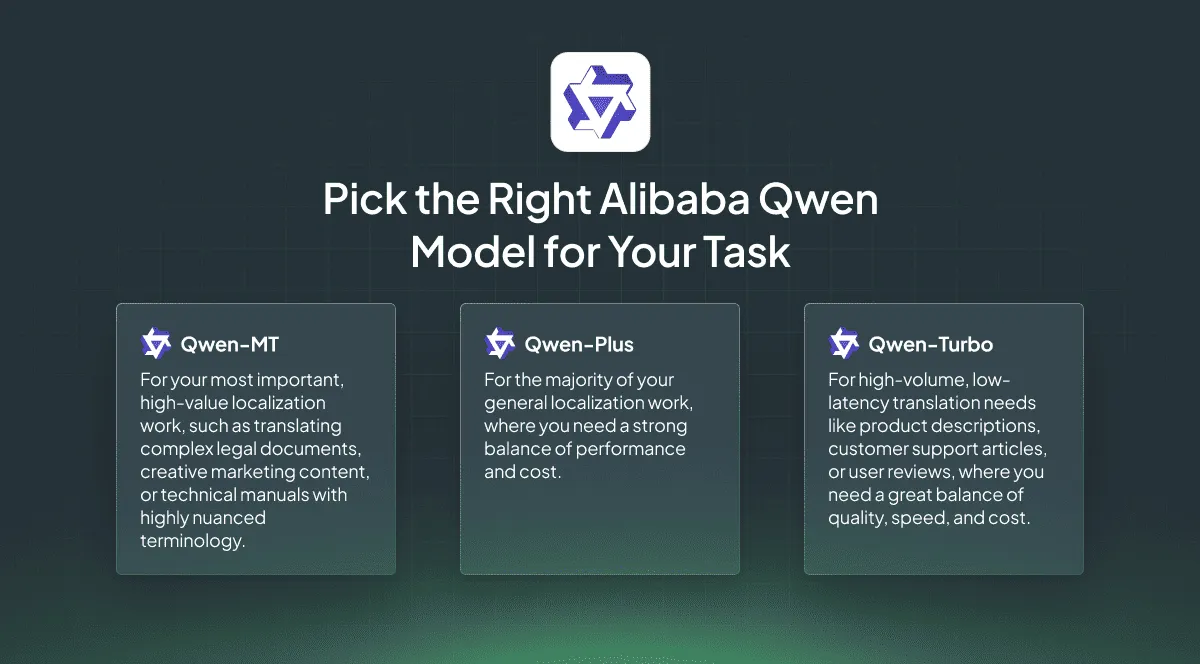
As we mentioned above, the most effective strategy for translation is not to choose a single model, but to use a hybrid approach that uses the unique strengths of each Qwen model.
- For High-Value Content: Use Qwen-MT for mission-critical, high-stakes translation where professional quality is essential.
- For General Content: Use Qwen-Plus for the majority of your general translation work, where you need a strong balance of performance and cost.
- For High-Volume Content: Use Qwen-Turbo or Qwen-Flash for high-volume, low-risk, or real-time tasks where speed and minimal cost are the main priorities.
By adopting this tiered strategy, localization teams can get the right level of quality for each task, while optimizing their workflow and budget.
Build a Multi-Model Strategy with Crowdin
The ideal strategy for translation is not to rely on a single, all-purpose model, as each LLM has its own unique strengths and weaknesses. The most effective approach for continuous localization is to adopt a flexible, hybrid workflow that allows you to use the right tool for the right job. All of this is possible with a platform like Crowdin.
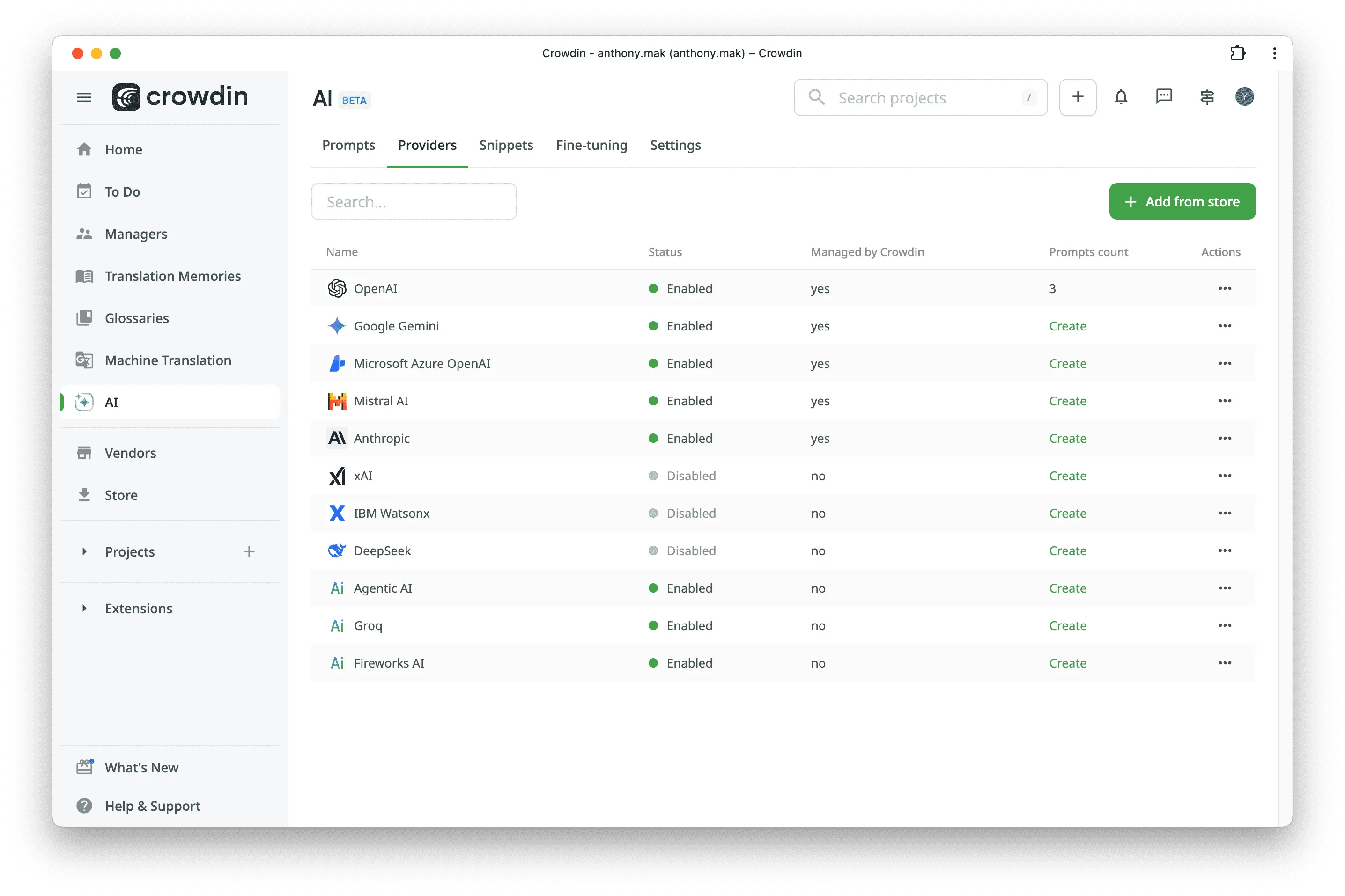
On Crowdin, you aren’t locked into a single provider. The platform acts as a central hub where you can connect, manage, and switch between various AI engines – including GPT, Gemini, Claude, and specialized models like Lara – to suit different content types and project needs. This allows you to:
- Experiment and Compare: Easily test and benchmark different LLMs with your specific content to see which one provides the best results for quality, tone, and cost.
- Create a Tiered Workflow: Use a high-cost, high-accuracy model like Claude Opus 4 for critical content, a balanced model like Gemini 2.5 Flash for your general website content, and a super-fast, low-cost model like GPT-5-nano for real-time chat or user-generated content. If you need a professional translation for critical and sensitive texts of documents, you can even use a specialized model like Lara for professional and highly nuanced translations.
- Optimize for Quality and Budget: By adopting this multi-model strategy, you can get the best possible translations for each part of your project while optimizing your budget and maintaining full control.
Moreover, Crowdin allows you to integrate a custom AI model. This gives you a lot of control. You can train the AI on your company’s specific words and style, which is perfect for things like technical manuals or legal documents.
With Crowdin, you have the flexibility to build a powerful and efficient localization pipeline tailored to your unique requirements.
Localize your product with Crowdin
FAQ
What is the best LLM for translation?
There is no single “best” LLM for all translation tasks. The ideal approach is to use a hybrid strategy that uses different models for different needs. For example, a high-quality model like GPT-5 can be used for critical content, while a faster, more cost-effective model like GPT-5-nano or Gemini 2.5 Flash can handle high-volume, low-risk content. If you need both speed and professional quality, with customised solutions (glossaries and TMs features included), then Lara is the best choice.
Why use a multi-model approach for translation?
A multi-model strategy allows you to optimize your workflow and budget by using the right model for the right task. This approach ensures you get the necessary quality for each piece of content while managing costs and maintaining efficiency. Platforms like Crowdin allow you to connect and switch between various AI engines to suit different content types and project needs.
Which LLMs are the most cost-effective for translation?
For high-volume, low-cost translation, you should choose models that are optimized for minimal expense. Examples include GPT-5-nano, Gemini 2.5 Flash-Lite, and the Qwen-Turbo & Qwen-Flash models. For professional high-level localization with medium-low volumes, Lara is a good option. Open-source models like Meta NLLB-200 are also a very cheap option, as the only cost is the computational resources to run them.
What is a “context window” and why is it important for translation?
The context window is the number of tokens an LLM can process at once. A larger context window allows the model to maintain consistency across long documents, such as books or technical manuals. This is a key challenge in translation, as it helps ensure that terminology and style remain consistent throughout the entire text. The Scout variant of Meta LLaMA 4 has an industry-leading context window of 10 million tokens.
Yuliia Makarenko
Yuliia Makarenko is a marketing specialist with over a decade of experience, and she’s all about creating content that readers will love. She’s a pro at using her skills in SEO, research, and data analysis to write useful content. When she’s not diving into content creation, you can find her reading a good thriller, practicing some yoga, or simply enjoying playtime with her little one.
